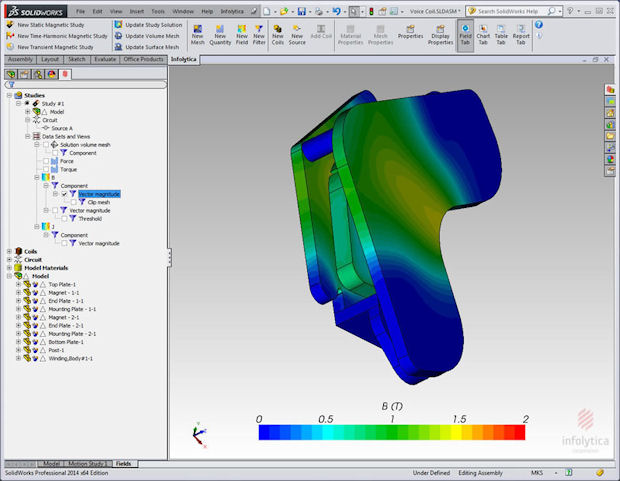Simulate 3D Electromagnetic Fields
Latest News
September 16, 2014
 Dear Desktop Engineering Reader:
Dear Desktop Engineering Reader:
Designing and optimizing robust low-frequency electromagnetic (EM) devices and systems is a specialized talent. Infolytica has been in the business of developing software for low-frequency EM analysis for nearly 40 years, so they have the chops. Recently, Infolytica released a nifty sounding tool set called MagNet for SolidWorks, and here’s why you might like to check it out.
MagNet for SolidWorks is a full 3D electromagnetic field simulator intended for engineers charged with designing and analyzing electromagnetic or electromechanical devices. It’s an integrated add-in to SolidWorks, not a stand-alone application. So, you invoke it from inside of your SolidWorks environment when you need it. The application employs a similar SolidWorks’ look and feel, so there’s nothing baffling about its interface for SolidWorks users.
“Integrated” and “look and feel” mean more than you stay within your comfort zone for design and analysis. It also means that you can run electromagnetic field simulations, measure your results and make geometry changes without the hassles of file import/export. MagNet for SolidWorks supports the third-party CAD import features that SolidWorks offers, so it fits into multi-CAD workflows.
MagNet for SolidWorks uses the finite element method to simulate static, frequency-dependent or transient electromagnetic fields. It can handle AC or time harmonic electromagnetic fields, magnetostatic fields and currents and proximity effects. You can use it to analyze all sorts of EM components, including actuators, power transformers, sensors, solenoids and even MRI (magnetic resonance imaging) devices.
This application comes with a predefined library of linear, nonlinear and anisotropic materials. Its adaptive meshing strategy helps you determine where you need refinements after each step. Its post-processing tools offer some unique features such as the ability to detach and move components in a field solution and slice and peel through field results.
OK, you get the idea that there’s a lot more to MagNet for SolidWorks than that brief outline. Today’s Check it Out links take you to much deeper details. In fact, it’s a trifecta.
The first link is to the MagNet for SolidWorks landing page. Scroll down a bit and click on the link to access granular details on the MagNet for SolidWorks feature set. Arrayed down the right-hand side are three videos. Watch them. They’re all less than two minutes long. One video covers creating coils. This neat functionality uses a lot of automation to help you set up coils, determine current flow and locate connected components. The other two videos offer quick demos of those post-processing tools mentioned above.
The second link takes you to a hands-on, technical report called “Rare Earth MRI Magnet Assembly.” This is an interesting piece of multimedia. The presentation looks at leveraging MagNet for SolidWorks to examine the use of rare-earth permanent magnets for generating a uniform field of 0.5 Tesla in an MRI device. It walks you through the methods used to approach the simulation and all the way to results analysis. The means to this end are 11 well-captioned screen captures (click on an image to enlarge) and a 16-second video. Very well done.
The third link goes to “Introduction to MagNet for SolidWorks,” an on-demand webinar (WebEx; registration required). This is an in-depth demonstration covering the major features and benefits of using MagNet for SolidWorks. You’ll see the process involved in executing an electromagnetic simulation and then analyzing results. The webinar runs 45 minutes, so set aside a block of time to take it in. It’s well worth your time watching this.
Infolytica is a Dassault SolidWorks Solution Partner and, judging by the level of integration between these two applications, that relationship seems quite tight. The potential productivity gains of a single design and analysis environment cannot be overstated, and MagNet for SolidWorks leaves the impression that it is a highly integrated, robust tool for electromagnetic analysis. Work your way through today’s Check it Out links and see for yourself.
Thanks, Pal. – Lockwood
Anthony J. Lockwood
Editor at Large, Desktop Engineering
Go here to access the MagNet for SolidWorks landing page.
Click here to go to the “Rare Earth MRI Magnet Assembly” technical report.
Register and watch the “Introduction to MagNet for SolidWorks” on-demand webinar here.
Subscribe to our FREE magazine, FREE email newsletters or both!
Latest News
About the Author
Anthony J. Lockwood is Digital Engineering’s founding editor. He is now retired. Contact him via [email protected].
Follow DE






